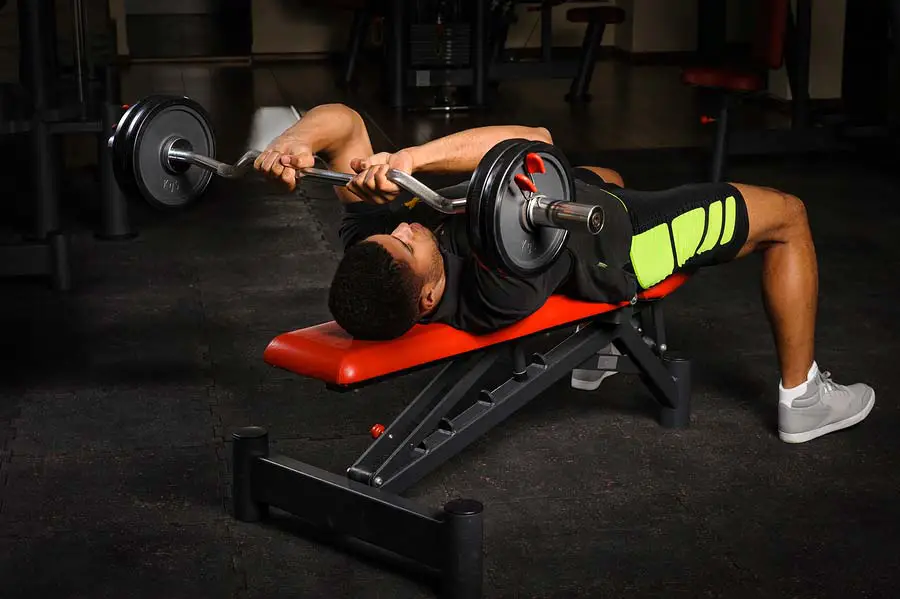In a head to head comparison, triceps rarely receive as much attention as biceps. However, the muscles running down the back of our upper arms are incredibly important for overall fitness. Exercises to strengthen the triceps should take a prominent place in our training plans.
If you’re looking to give your triceps a good workout, the french press exercise is a must-do. That said, this popular movement is often performed incorrectly.
To ensure that you make the most of your workout, here’s our ultimate guide to doing the french press fitness exercise correctly, every time.
Contents [hide]
What Is The French Press?
Also known as triceps extensions or “skull crushers,” the exercise called the “french press” is designed to build strength in your triceps. The triceps are the large muscles on the back of your upper arm, and they allow you to extend your elbow.
This movement is known as an “isolation exercise” because it places most of the load on the target muscle – in this case, the triceps. In addition to the triceps, the french press exercise trains the following muscles:
- Abdominals: Rectus abdominis and obliques
- Chest: Upper and lateral pectoralis major
- Shoulders: Deltoids and rotator cuff muscles
- Back: Rhomboids and trapezius
- Wrist: Flexor carpi radialis
Despite all the additional benefits, the primary purpose of the french press will always be to train the triceps. Triceps often go-underworked in more popular exercises (such as the bench press), so the french press is meant to specifically target the posterior region of the upper arm.
How To Perform The French Press Exercise
There are many different variants to the french press, each of which has its unique advantages and disadvantages. Here’s what you need to know to perform each variation:
1. French Press Exercise – Flat Bench
The standard french press exercise is performed lying down on a flat bench with a barbell. In general, an EZ-bar is best for this movement because it places your wrists and elbows in a more comfortable position.
To perform the standard version of this exercise, do the following:
- Lie down on a flat bench, grasping an EZ bar loaded with your desired weight. When holding the bar at your waist, your palms should face toward you, and your wrists should stay in a straight position.
- Raise the bar above your head and extend your arms. Keep your core tight and stay balanced on the flat bench.
- Slowly lower the bar down until it is at your forehead. Then, slowly lift it back up to its initial position. While doing this, take care not to move your elbows or swing your arm throughout the movement.
- Repeat step three until you reach the desired number of reps per set.
2. Standing French Press Exercise
In the absence of a flat bench, the french press can be performed standing. When you use this version of the exercise, you engage your core, which provides an excellent all-around upper body workout.
Again, an EZ bar is preferred for this movement because it puts less pressure on your joints. To perform the standing french press, do the following:
- Grab an EZ bar loaded to your desired weight so that your palms are facing toward you. In this exercise, the placement of your hands is the opposite of what you’d do for a bicep curl.
- Stand with your feet shoulder-width apart, and your knees slightly bent.
- While keeping your core tight, raise the bar above your head.
- Next, while keeping your elbows in the same position, slowly lower the bar behind your head.
- Raise the bar back to its starting position without allowing your elbows to change position.
- Repeat steps 4 and 5 until you reach the desired number of reps per set.
3. French Press Exercise – Seated
The seated french press is one of the most common variations of this exercise. To perform this variant, you’ll need a flat bench or something else that’s sturdy enough to sit on.
In this version, the movement is more or less the same as what you’d do for the standing french press. However, sitting down provides you with more balance and stability. It also requires less core strength.
You can even perform this exercise while sitting on a weight bench in the full upright position. The back support from the bench provides extra stability and helps you better target the triceps.
4. French Press Exercise – Incline Bench
The incline bench variation of the french press is performed exactly like the flat bench version but on an inclined surface.
While the flat bench movement focuses most of the tension on the long head of the triceps, this alternative puts more stress on the lateral and medial triceps. Additionally, placing the body at an incline also involves more of the pectoral and forearm muscles in the movement.
5. French Press Exercise Dumbell
Any of the first four variations of the french press that we’ve discussed so far can be done with dumbells. Using dumbells can help ensure that both of your triceps are worked equally and that your stronger arm doesn’t compensate for the other.
To perform the french press exercise dumbbell variation, simply swap out dumbbells for your barbells. You can also choose to do this exercise single-handed, focusing on just one arm at a time.
6. Kettlebell French Press
The final version of the french press is performed with a kettlebell. This is a great option if you don’t have a bench. Here’s what you need to do:
- Grab a kettlebell and a yoga mat. Roll out the mat in a flat location and then lie down on the floor.
- While bending your legs at the knees, raise the kettlebell above your head.
- Then, keeping the rest of your body still, bend your arm at the elbow, and slowly lower the kettlebell behind your head. Stop the kettlebell before it hits the ground.
- Slowly raise the kettlebell back to the starting position.
- Repeat steps 3 and 4 until you complete the desired number of reps.
Note that this exercise is generally performed with just one kettlebell. If you’re feeling particularly strong, you can try doing it with two, but make sure that your technique is perfect the whole time.
French Press Exercise Tips & Technique
As with any exercise, technique is critical when performing the french press. Here are some things to keep in mind while training:
- Exhale When Raising The Bar. The correct way to breathe during this exercise is to exhale when you raise the bar away from you. Then, you can inhale as you lower the bar or dumbbell back toward your body.
- Keep Your Body Still. This is particularly important when performing the standing version of the exercise. Avoid swinging or swaying as much as possible, as this redirects some of the tension away from your triceps.
- Don’t Let Your Elbows Move. Your elbows will naturally want to flare out off to the side as you lower and raise the barbell. Focus on keeping your elbows in the same position throughout the entire exercise.
- Avoid Locking Your Elbows. Not only can locking your elbows cause hyperextension, it takes the tension off of your triceps at the top of the movement. This means you won’t get as good a workout in your triceps if you allow your elbows to lock on every rep.
- Keep Your Head In A Neutral Position. Your head should stay in a neutral position with your eyes facing forward throughout the exercise. Moving your head can strain your neck and can cause injuries.
- Light Weight, High Reps. The french press puts a lot of strain on your shoulders, wrists, and elbows. So, to reduce your likelihood of injury, it’s best to go with light weights, high reps. Aim for 10-12 reps per set when doing this exercise.








Leave A Comment